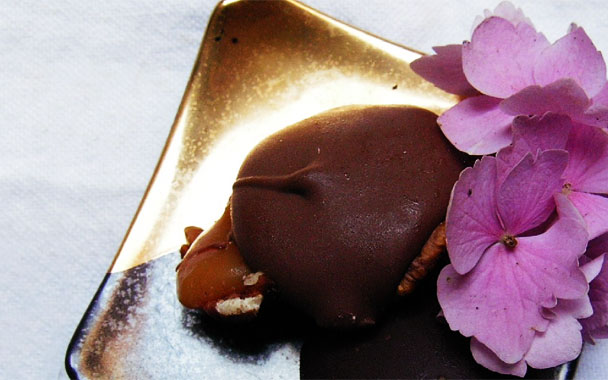I needn’t tell you that Midwesterners are particularly fond of chocolates. When I was growing up in Chicago and Minneapolis, I was never far from a Fanny May or a Fanny Farmer chocolate shop. Both names provoked peels of laughter from my group of friends, though we loved the chocolates, especially those filled with maple fondant and butter brickle. When no one was looking, we’d poke the bottoms of every chocolate in a box to help us avoid the ones with bits of orange peel, marshmallows, or runny fruit syrups—and to find our collective favorite: the turtle, a clutch of toasted nuts mired in thick caramel and covered with chocolate. Dark or milk, it didn’t matter to us. I now realize that it was the salt on the nuts and in the caramel that knocked the flavor into orbit.
When my wife, who hails from DePere, Wisconsin, told me her hometown has the best turtles in the world, I was immediately skeptical. She arranged for her mother to send us a box the following Christmas. The minute I tried them, I had to admit she was right. The box contained assorted turtles, which the company calls “snappers,” as if to one-up the reference to the common box turtle one often sees trying to cross country roads. To the uninitiated, a real, live snapper is a turtle with a fierce bony beak. Some specimens attain lengths of six feet or more, and the rumor that a pond on the golf course harbors a giant snapping turtle will prevent golfers and caddies alike from retrieving a ball from the pond, for fear of losing a leg—or at least a finger.
Like their namesake, these chocolate “snappers” are turtles with an aggressive difference. They possess an atypical confectionary configuration: Instead of being entirely coated with chocolate, the chocolate component is consolidated into a large medallion that rests atop a free-form flow of thick caramel and nuts. Half the snappers in our Christmas box were milk chocolate and the other half were dark. Each of the types in turn included half pecan and half cashew snappers, so there were four varieties in all. I found all of them delectable. And I had to know where my mother-in-law got them.
My wife told me the snappers came from Seroogy’s in DePere, a company founded by three brothers who emigrated from Lebanon in the late 19th century to work in the paper mills that line the Fox River, which runs through the town. The brothers opened a restaurant and ice cream shop in 1899, and soon began selling chocolates as well. Eventually, the restaurant and ice cream shop withered away, leaving only the chocolate business, which has persisted to this day. It’s now under the care of a third generation of Seroogy brothers who use the same snapper recipes developed over a century ago when their grandfather and great-uncles arrived from Lebanon, focusing on scintillatingly fresh, well-toasted nuts.
So, my wife was almost right. The best turtles in America—perhaps the world—don’t come from Chicago or Minneapolis. But they’re not exactly from DePere either. They really hail from Lebanon, from a family that remains a testament to the long-lasting contributions of Lebanese-Americans to the American heartland.


